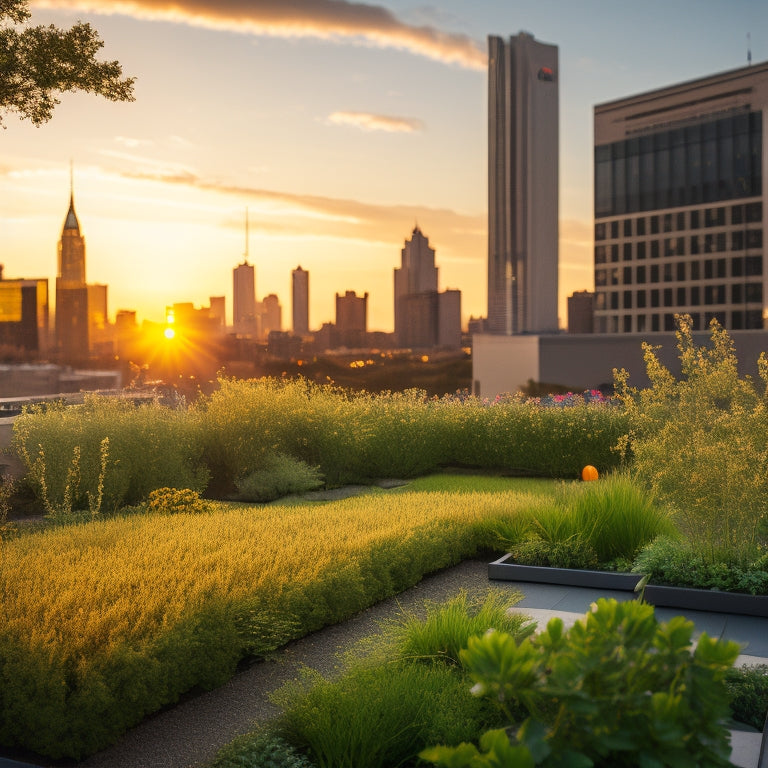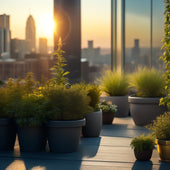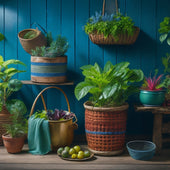
7 Essential Tips for Rooftop Garden Irrigation Care
Share
As you tend to your rooftop garden, prioritize irrigation care to prevent waterlogged soil and root rot. Inspect and clean irrigation lines regularly to guarantee proper water flow, and replace worn parts like filters, emitters, and micro-sprinklers every 2-3 months. Check water pressure and flow, aiming for 30-50 PSI, and monitor soil moisture levels to avoid overwatering. Adjust irrigation schedules seasonally, and maintain timer accuracy by replacing batteries every 6-12 months. Perform regular system audits to catch potential issues before they escalate, and fine-tune your watering techniques to enhance plant health and growth - next, discover how to optimize your system for peak performance.
Key Takeaways
• Regularly inspect and clean irrigation lines to ensure proper water flow and prevent clogs and blockages.
• Conduct periodic system audits to identify and address potential issues before they escalate, ensuring optimal water distribution.
• Monitor soil moisture levels using sensors to avoid overwatering or underwatering, and adjust irrigation schedules accordingly.
• Adjust irrigation schedules seasonally to accommodate changes in temperature and precipitation, and fine-tune watering techniques for specific plant types.
• Maintain accurate irrigation timer settings and replace batteries regularly to ensure reliable performance and optimal watering schedules.
Inspect and Clean Irrigation Lines
As you begin maintaining your rooftop garden's irrigation system, start by visually inspecting the lines for signs of damage, kinking, or blockages that could impede water flow. Look for cracks, cuts, or corrosion that may have developed over time.
Check for kinks or bends that could restrict water flow, and straighten them out if necessary. Also, inspect the lines for blockages, such as debris or sediment buildup, that could clog the system.
Next, focus on filter maintenance to guarantee your irrigation system is running efficiently. Check your filters regularly and clean or replace them as needed. Clogged filters can reduce water pressure and flow, leading to ineffective watering and potentially damaging your plants.
Proper drainage is also essential to prevent waterlogged soil and root rot. Consider implementing drainage solutions, such as French drains or drainage mats, to direct excess water away from your plants.
Check Water Pressure and Flow
When you turn on your rooftop garden's irrigation system, you expect water to flow smoothly and efficiently.
However, inadequate water pressure and flow can lead to under-watered plants, wasted resources, and system damage.
To avoid these issues, you'll need to guarantee your system operates within the ideal pressure range, measure flow rates, and perform regular checks on pressure regulators.
Optimal Pressure Range
You'll need to guarantee your rooftop garden's irrigation system operates within an ideal pressure range of 30-50 pounds per square inch (PSI) to prevent under- or over-watering, which can lead to plant stress and system damage.
This optimal pressure range guarantees that your drip irrigation system delivers water directly to the roots of your plants without wasting a single drop. Pressure optimization is vital, as it affects the performance of your irrigation system and the health of your plants.
If the pressure is too low, water may not reach all areas of your rooftop garden, resulting in under-watered plants. On the other hand, excessive pressure can lead to over-watering, causing erosion, runoff, and waterlogged soil.
To achieve the perfect balance, you can install a pressure regulator or adjust the pump's output to guarantee the ideal pressure range. By doing so, you'll be able to maintain a healthy and thriving rooftop garden, while also preventing system damage and reducing water waste.
Flow Rate Measurement
Measure the flow rate of your rooftop garden's irrigation system by checking the water pressure and flow at the point of delivery, typically at the irrigation head or emitter, to make sure it's within the recommended range for ideal plant growth and system performance.
You can do this by installing flow sensors, which provide accurate readings of water flow rates. For drip irrigation systems, it's vital to guarantee the flow rate is consistent throughout the network to prevent under-watering or over-watering.
Visual inspections are also important. Check the irrigation heads or emitters for signs of clogging or blockages, which can affect flow rates. Verify that the flow rate is within the manufacturer's recommended range for your specific drip irrigation system.
If you're unsure about the recommended flow rate, consult your system's manual or contact the manufacturer. By regularly measuring the flow rate, you'll be able to identify potential issues before they cause harm to your plants or system.
This proactive approach guarantees your rooftop garden receives the right amount of water, promoting healthy growth and minimizing waste.
Pressure Regulator Checks
Check your pressure regulator to verify it's maintaining the recommended pressure range, typically between 20 and 40 psi, to prevent damage to your rooftop garden's irrigation system and promote ideal water flow.
You'll want to guarantee the regulator is compatible with your system's specific requirements. Incorrect pressure can lead to inefficient watering, wasting resources, and even damaging your plants.
Perform a visual inspection of the regulator, looking for signs of wear or corrosion.
Check the gauge to guarantee it's accurately displaying the pressure reading. If you notice any issues, consider replacing the regulator to prevent further problems.
Make any necessary pressure adjustments to guarantee the recommended range is maintained.
Monitor Soil Moisture Levels
Soil probes or moisture meters help determine when your rooftop garden's soil has reached its ideal moisture level, usually between 20% and 40% water-holding capacity. This is vital, as overwatering can lead to root rot and underwatering can cause drought stress. By regularly checking soil moisture levels, you can guarantee your plants receive the right amount of water.
Here are three essential tips to keep in mind:
-
Use soil moisture sensors: These devices provide accurate readings of soil moisture levels, taking the guesswork out of watering. You can purchase sensors that connect to your smartphone, making it easy to monitor soil moisture remotely.
-
Choose drought-resistant plants: Select plants that are adapted to your local climate and can thrive with minimal watering. This will reduce the risk of overwatering and minimize water waste.
-
Check soil moisture during extreme weather: During heatwaves or heavy rainfall, soil moisture levels can fluctuate rapidly. Regular checks will guarantee your plants receive the right amount of water, even in challenging weather conditions.
Adjust Irrigation Schedules Seasonally
As the seasons change, you'll need to fine-tune your rooftop garden's irrigation schedule to accommodate shifting temperature and precipitation patterns.
During the hot summer months, your plants will require more frequent watering, while the cooler winter months will necessitate less. Make seasonal plant adjustments by taking into account the specific needs of your plants during each season. For instance, flowering plants may require more water during the spring, while succulents may need less during the winter.
Weather pattern considerations are also essential. If you live in an area prone to heavy rainfall, you may need to adjust your irrigation schedule accordingly. Conversely, if you're experiencing a drought, you'll need to increase watering frequency.
Keep an eye on local weather forecasts to verify you're not overwatering or underwatering your plants. Remember, a well-adjusted irrigation schedule is key to maintaining a healthy and thriving rooftop garden.
Maintain Irrigation Timer Accuracy
To guarantee your rooftop garden receives the right amount of water, you need to maintain the accuracy of your irrigation timer.
You'll want to pay attention to the timer's battery life, as a dead battery can disrupt your watering schedule.
Timer Battery Replacement
You'll want to replace your irrigation timer's batteries every 6-12 months to prevent inaccurate scheduling and guarantee your rooftop garden receives the right amount of water. This confirms your plants get the necessary hydration, and you avoid overwatering or underwatering.
When replacing batteries, consider the following:
-
Choose the right battery type: Alkaline or lithium batteries are recommended for most irrigation timers. Check your timer's manual for specific recommendations.
-
Select a reliable timer brand: Opt for reputable brands like Rain Bird, Hunter, or Orbit, which offer high-quality timers with accurate scheduling.
-
Keep spare batteries on hand: Store spare batteries in a cool, dry place to confirm they remain functional when you need them.
Scheduled Watering Reminders
Set reminders to review and adjust your irrigation schedule regularly, guaranteeing your rooftop garden receives ideal watering levels and minimizing the risk of overwatering or underwatering. This is vital, as inconsistent watering can lead to plant stress, disease, and pest issues.
By scheduling regular reviews, you'll be able to fine-tune your watering techniques to meet the unique needs of your rooftop garden. As you review your schedule, consider factors such as weather patterns, soil moisture, and plant hydration levels.
Make adjustments as needed to confirm your plants are receiving the right amount of water at the right time. It's also essential to account for seasonal changes, as plant water requirements can vary greatly between summer and winter months.
Inspect and Replace Worn Parts
Regularly scrutinizing your rooftop garden's irrigation system uncovers worn parts that can lead to inefficient water distribution and plant damage.
As you inspect your system, pay attention to signs of wear and tear, such as cracks, corrosion, or mineral buildup. These issues can greatly reduce irrigation efficiency, causing your plants to suffer.
Here are three critical components to inspect and replace regularly:
-
Filter screens: Clogged filter screens can reduce water pressure, affecting the performance of your drip irrigation system. Clean or replace them every 2-3 months to guarantee ideal irrigation efficiency.
-
Tubing and fittings: Inspect your tubing and fittings for cracks, kinks, or signs of wear. Replace them promptly to prevent leaks and maintain consistent water distribution.
-
Emitters and micro-sprinklers: Check emitters and micro-sprinklers for clogs or mineral buildup, which can reduce water flow. Clean or replace them as needed to guarantee your plants receive the right amount of water.
Perform Regular System Audits
To guarantee your rooftop garden's irrigation system operates at peak performance, schedule periodic audits to catch any underlying issues before they escalate into major problems.
During these audits, inspect the entire system, from the water source to the emitters, to identify any leaks, clogs, or malfunctions. Check the drainage solutions to verify they're functioning correctly, preventing waterlogged soil and root rot. Confirm that the irrigation schedule is aligned with the plant selection, taking into account the specific water requirements of each species.
Pay attention to the system's pressure and flow rates, as well as the uniformity of water distribution. Are there any areas receiving too much or too little water? Make adjustments as needed to optimize the system's performance.
Keep a record of your findings and any repairs or maintenance performed during the audit. This will help you track patterns and identify potential issues before they become major problems.
Frequently Asked Questions
Can I Use a Drip Irrigation System on a Rooftop Garden?
You can definitely use a drip irrigation system on your rooftop garden, as it offers precise water delivery, reducing evaporation and runoff, and increasing rooftop water efficiency, while also minimizing waste and ensuring a safe, healthy growing environment.
How Often Should I Check for Leaks in the Irrigation System?
You should regularly inspect your rooftop garden's irrigation system for leaks, ideally every 2-3 weeks, to guarantee efficient water distribution and prevent waterlogged soil, making leak detection a vital part of irrigation maintenance.
Are There Any Specific Irrigation Timers for Rooftop Gardens?
When selecting an irrigation timer for your rooftop garden, look for models with automatic watering features and water conservation settings, allowing you to precisely control water distribution and minimize waste, ensuring a safe and efficient watering process.
What Is the Best Type of Irrigation Hose for Rooftop Use?
As you navigate the rooftop garden's twists and turns, you'll need a reliable irrigation hose that's as flexible as a snake - opt for a soaker hose or flexible tubing, designed to withstand UV rays and harsh weather conditions.
Do I Need to Winterize My Rooftop Garden's Irrigation System?
You'll need to winterize your rooftop garden's irrigation system to prevent damage from freezing temps; employ winterizing techniques like draining and insulating pipes to guarantee proper irrigation maintenance and avoid costly repairs come spring.
Related Posts
-

Why Choose Cinder for Your Rooftop Garden Planters
You choose cinder for your rooftop garden planters because they offer a unique combination of durability, versatility...
-

Why Choose Cinder for Your Rooftop Garden Planters
You choose cinder for your rooftop garden planters because they offer a unique combination of durability, versatility...
-

Why Choose Cinder for Your Rooftop Garden Planters
You choose cinder for your rooftop garden planters because they offer a unique combination of durability, versatility...
-

Why Choose Cinder for Your Rooftop Garden Planters
You choose cinder for your rooftop garden planters because they offer a unique combination of durability, versatility...
-

Why Choose Cinder for Your Rooftop Garden Planters
You choose cinder for your rooftop garden planters because they offer a unique combination of durability, versatility...
-

Why Choose Cinder for Your Rooftop Garden Planters
You choose cinder for your rooftop garden planters because they offer a unique combination of durability, versatility...
-

Why Choose Cinder for Your Rooftop Garden Planters
You choose cinder for your rooftop garden planters because they offer a unique combination of durability, versatility...
-

Why Choose Cinder for Your Rooftop Garden Planters
You choose cinder for your rooftop garden planters because they offer a unique combination of durability, versatility...
-

Why Choose Cinder for Your Rooftop Garden Planters
You choose cinder for your rooftop garden planters because they offer a unique combination of durability, versatility...
-

Why Choose Cinder for Your Rooftop Garden Planters
You choose cinder for your rooftop garden planters because they offer a unique combination of durability, versatility...
-

Why Choose Cinder for Your Rooftop Garden Planters
You choose cinder for your rooftop garden planters because they offer a unique combination of durability, versatility...
-

Why Choose Cinder for Your Rooftop Garden Planters
You choose cinder for your rooftop garden planters because they offer a unique combination of durability, versatility...
-

Why Choose Cinder for Your Rooftop Garden Planters
You choose cinder for your rooftop garden planters because they offer a unique combination of durability, versatility...
-

Why Choose Cinder for Your Rooftop Garden Planters
You choose cinder for your rooftop garden planters because they offer a unique combination of durability, versatility...
-

Why Choose Cinder for Your Rooftop Garden Planters
You choose cinder for your rooftop garden planters because they offer a unique combination of durability, versatility...
-

Why Choose Cinder for Your Rooftop Garden Planters
You choose cinder for your rooftop garden planters because they offer a unique combination of durability, versatility...
-

Why Choose Cinder for Your Rooftop Garden Planters
You choose cinder for your rooftop garden planters because they offer a unique combination of durability, versatility...
-

Why Choose Cinder for Your Rooftop Garden Planters
You choose cinder for your rooftop garden planters because they offer a unique combination of durability, versatility...
-

Why Choose Cinder for Your Rooftop Garden Planters
You choose cinder for your rooftop garden planters because they offer a unique combination of durability, versatility...
-

Why Choose Cinder for Your Rooftop Garden Planters
You choose cinder for your rooftop garden planters because they offer a unique combination of durability, versatility...
-

Why Choose Cinder for Your Rooftop Garden Planters
You choose cinder for your rooftop garden planters because they offer a unique combination of durability, versatility...
-

Why Choose Cinder for Your Rooftop Garden Planters
You choose cinder for your rooftop garden planters because they offer a unique combination of durability, versatility...
-

Why Choose Cinder for Your Rooftop Garden Planters
You choose cinder for your rooftop garden planters because they offer a unique combination of durability, versatility...
-

Why Choose Cinder for Your Rooftop Garden Planters
You choose cinder for your rooftop garden planters because they offer a unique combination of durability, versatility...
-

Why Choose Cinder for Your Rooftop Garden Planters
You choose cinder for your rooftop garden planters because they offer a unique combination of durability, versatility...
-

Why Choose Cinder for Your Rooftop Garden Planters
You choose cinder for your rooftop garden planters because they offer a unique combination of durability, versatility...
-

Why Choose Cinder for Your Rooftop Garden Planters
You choose cinder for your rooftop garden planters because they offer a unique combination of durability, versatility...
-

Why Choose Cinder for Your Rooftop Garden Planters
You choose cinder for your rooftop garden planters because they offer a unique combination of durability, versatility...
-

7 Creative Upcycled Planter Tutorials to Try Now
Get ready to transform your outdoor space with these 7 creative upcycled planter tutorials! Start by turning cinder b...
-

7 Creative Upcycled Planter Tutorials to Try Now
Get ready to transform your outdoor space with these 7 creative upcycled planter tutorials! Start by turning cinder b...
-

7 Creative Upcycled Planter Tutorials to Try Now
Get ready to transform your outdoor space with these 7 creative upcycled planter tutorials! Start by turning cinder b...
-

7 Creative Upcycled Planter Tutorials to Try Now
Get ready to transform your outdoor space with these 7 creative upcycled planter tutorials! Start by turning cinder b...
-

7 Creative Upcycled Planter Tutorials to Try Now
Get ready to transform your outdoor space with these 7 creative upcycled planter tutorials! Start by turning cinder b...
-

7 Creative Upcycled Planter Tutorials to Try Now
Get ready to transform your outdoor space with these 7 creative upcycled planter tutorials! Start by turning cinder b...
-

7 Creative Upcycled Planter Tutorials to Try Now
Get ready to transform your outdoor space with these 7 creative upcycled planter tutorials! Start by turning cinder b...
-

7 Creative Upcycled Planter Tutorials to Try Now
Get ready to transform your outdoor space with these 7 creative upcycled planter tutorials! Start by turning cinder b...
-

7 Creative Upcycled Planter Tutorials to Try Now
Get ready to transform your outdoor space with these 7 creative upcycled planter tutorials! Start by turning cinder b...
-

7 Creative Upcycled Planter Tutorials to Try Now
Get ready to transform your outdoor space with these 7 creative upcycled planter tutorials! Start by turning cinder b...
-

7 Creative Upcycled Planter Tutorials to Try Now
Get ready to transform your outdoor space with these 7 creative upcycled planter tutorials! Start by turning cinder b...
-

7 Creative Upcycled Planter Tutorials to Try Now
Get ready to transform your outdoor space with these 7 creative upcycled planter tutorials! Start by turning cinder b...
-

7 Creative Upcycled Planter Tutorials to Try Now
Get ready to transform your outdoor space with these 7 creative upcycled planter tutorials! Start by turning cinder b...
-

7 Creative Upcycled Planter Tutorials to Try Now
Get ready to transform your outdoor space with these 7 creative upcycled planter tutorials! Start by turning cinder b...
-

7 Creative Upcycled Planter Tutorials to Try Now
Get ready to transform your outdoor space with these 7 creative upcycled planter tutorials! Start by turning cinder b...
-

7 Creative Upcycled Planter Tutorials to Try Now
Get ready to transform your outdoor space with these 7 creative upcycled planter tutorials! Start by turning cinder b...
-

7 Creative Upcycled Planter Tutorials to Try Now
Get ready to transform your outdoor space with these 7 creative upcycled planter tutorials! Start by turning cinder b...
-

7 Creative Upcycled Planter Tutorials to Try Now
Get ready to transform your outdoor space with these 7 creative upcycled planter tutorials! Start by turning cinder b...
-

7 Creative Upcycled Planter Tutorials to Try Now
Get ready to transform your outdoor space with these 7 creative upcycled planter tutorials! Start by turning cinder b...
-

7 Creative Upcycled Planter Tutorials to Try Now
Get ready to transform your outdoor space with these 7 creative upcycled planter tutorials! Start by turning cinder b...
-

7 Creative Upcycled Planter Tutorials to Try Now
Get ready to transform your outdoor space with these 7 creative upcycled planter tutorials! Start by turning cinder b...
-

7 Creative Upcycled Planter Tutorials to Try Now
Get ready to transform your outdoor space with these 7 creative upcycled planter tutorials! Start by turning cinder b...
-

7 Creative Upcycled Planter Tutorials to Try Now
Get ready to transform your outdoor space with these 7 creative upcycled planter tutorials! Start by turning cinder b...
-

7 Creative Upcycled Planter Tutorials to Try Now
Get ready to transform your outdoor space with these 7 creative upcycled planter tutorials! Start by turning cinder b...
-

5 Tips for Shaded Area Gardening Success
To turn your shaded areas into thriving gardens, start by selecting shade-tolerant crops like leafy greens and herbs,...
-

5 Tips for Shaded Area Gardening Success
To turn your shaded areas into thriving gardens, start by selecting shade-tolerant crops like leafy greens and herbs,...
-

5 Tips for Shaded Area Gardening Success
To turn your shaded areas into thriving gardens, start by selecting shade-tolerant crops like leafy greens and herbs,...
-

5 Tips for Shaded Area Gardening Success
To turn your shaded areas into thriving gardens, start by selecting shade-tolerant crops like leafy greens and herbs,...
-

5 Tips for Shaded Area Gardening Success
To turn your shaded areas into thriving gardens, start by selecting shade-tolerant crops like leafy greens and herbs,...
-

5 Tips for Shaded Area Gardening Success
To turn your shaded areas into thriving gardens, start by selecting shade-tolerant crops like leafy greens and herbs,...
-

5 Tips for Shaded Area Gardening Success
To turn your shaded areas into thriving gardens, start by selecting shade-tolerant crops like leafy greens and herbs,...
-

5 Tips for Shaded Area Gardening Success
To turn your shaded areas into thriving gardens, start by selecting shade-tolerant crops like leafy greens and herbs,...
-

5 Tips for Shaded Area Gardening Success
To turn your shaded areas into thriving gardens, start by selecting shade-tolerant crops like leafy greens and herbs,...
-

5 Tips for Shaded Area Gardening Success
To turn your shaded areas into thriving gardens, start by selecting shade-tolerant crops like leafy greens and herbs,...
-

5 Tips for Shaded Area Gardening Success
To turn your shaded areas into thriving gardens, start by selecting shade-tolerant crops like leafy greens and herbs,...
-

5 Tips for Shaded Area Gardening Success
To turn your shaded areas into thriving gardens, start by selecting shade-tolerant crops like leafy greens and herbs,...
-

5 Tips for Shaded Area Gardening Success
To turn your shaded areas into thriving gardens, start by selecting shade-tolerant crops like leafy greens and herbs,...
-

5 Tips for Shaded Area Gardening Success
To turn your shaded areas into thriving gardens, start by selecting shade-tolerant crops like leafy greens and herbs,...
-

5 Tips for Shaded Area Gardening Success
To turn your shaded areas into thriving gardens, start by selecting shade-tolerant crops like leafy greens and herbs,...
-

5 Tips for Shaded Area Gardening Success
To turn your shaded areas into thriving gardens, start by selecting shade-tolerant crops like leafy greens and herbs,...
-

5 Tips for Shaded Area Gardening Success
To turn your shaded areas into thriving gardens, start by selecting shade-tolerant crops like leafy greens and herbs,...
-

5 Tips for Shaded Area Gardening Success
To turn your shaded areas into thriving gardens, start by selecting shade-tolerant crops like leafy greens and herbs,...
-

5 Tips for Shaded Area Gardening Success
To turn your shaded areas into thriving gardens, start by selecting shade-tolerant crops like leafy greens and herbs,...
-

5 Tips for Shaded Area Gardening Success
To turn your shaded areas into thriving gardens, start by selecting shade-tolerant crops like leafy greens and herbs,...


